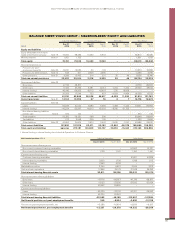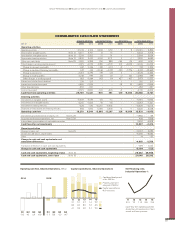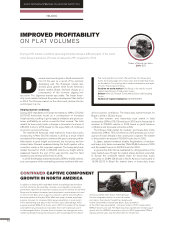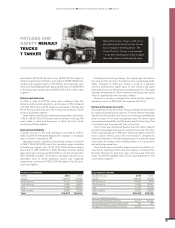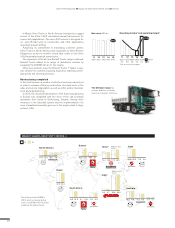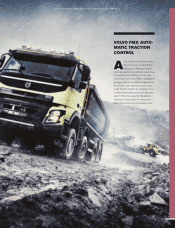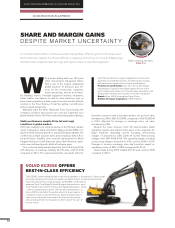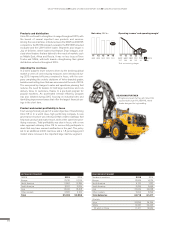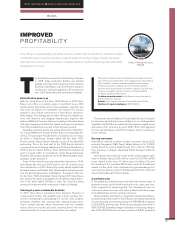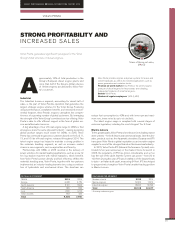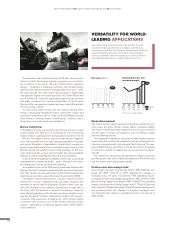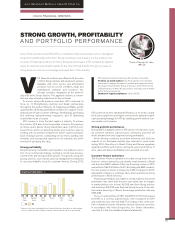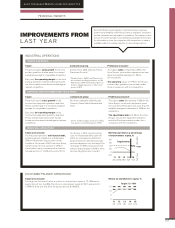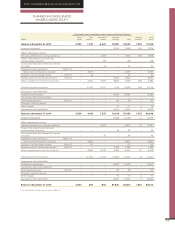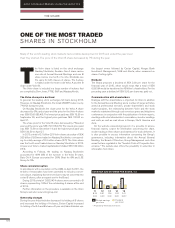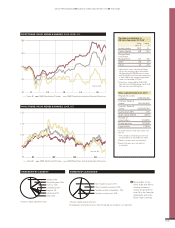Volvo 2015 Annual Report Download - page 97
Download and view the complete annual report
Please find page 97 of the 2015 Volvo annual report below. You can navigate through the pages in the report by either clicking on the pages listed below, or by using the keyword search tool below to find specific information within the annual report.
The first Volvo bus rolled out of the factory in Sweden
in 1928. Today production facilities are situated
globally in Europe, North America, South America
and Asia. Volvo Buses’ safe and efficient transport
solutions are sold and supported in 85 countries by
over 1,500 dealerships and workshops worldwide.
Electrification powers up
With the introduction of the Volvo 7900 Electric in 2015, Volvo
Buses now offers a complete range of electrified buses. With
hybrid, electric hybrid and electric buses available, customers can
now cover all aspects of sustainable city mobility. The product
portfolio is one of three cornerstones in Volvo Buses’ electromo-
bility strategy. This strategy also includes offering of complete sys-
tems with batteries and charging infrastructure, together with
partners ABB and Siemens, that can be paid per kilometer, along
with open charging interfaces that enable customers to run buses
from other manufacturers as well in their transport system.
Operating extremely quietly, the exhaust-free Volvo 7900 Elec-
tric is about 80% more energy-efficient than a corresponding die-
sel bus. The passenger-friendly electric concept buses run in regu-
lar traffic in Gothenburg, Sweden along with the Volvo 7900
Electric hybrids (diesel-electric hybrids), as part of the ElectriCity
partnership. This is the third start of the 7900 Electric hybrid in
commercial service following Hamburg in 2014 and Stockholm in
2015. In the first half of 2016 six Volvo 7900 Electric Hybrids will
start in regular traffic in Luxembourg. Using Group technology,
Nova Bus will introduce an electric bus in the Montreal public trans-
portation system early 2017.
Sales of Volvo hybrid buses passed another milestone in 2015.
Volvo Buses has sold over 2,300 units in over 20 countries since
their introduction in 2010. Among the newly added markets are
Denmark, France and Poland. Also, 28 articulated hybrid buses are
now transporting passengers in Budapest – the largest order ever
for the Volvo 7900 Articulated Hybrid. During 2015 Volvo Buses
also took the first steps in preparation for the forthcoming introduc-
tion of the Volvo Hybrid City Bus in India. The buses are being
produced in India and will be introduced in traffic in Mumbai.
Steering in a more sustainable direction
In 2015 Volvo Buses introduced Volvo Dynamic Steering in
several coach models. This breakthrough in driver working envi-
ronment compensates automatically for uneven road surfaces,
eliminates vibrations and ‘steering kick’, making driving easier.
Fewer manual steering wheel movements and less vibration
reduce stress on muscles and joints, meaning drivers feel more
relaxed and able to remain focused and drive more safely.
IMPROVED
PROFITABILITY
Volvo Buses is spearheading innovative vehicles systems that accelerate the transition towards
sustainable public transport solutions. A global leader, its product range includes city buses,
intercity buses and coaches, as well as complete transport systems, financing, fleetand traffic
management services.
The year also saw Volvo Buses’ five and eight liter Euro 6 engines
for city buses and intercity buses certified to run on Hydrogenated
Vegetable Oils (HVO), a renewable fuel that replaces regular diesel
and reduces CO2 emissions by up to 90%. HVO is also approved
for use in all Volvo Buses with Euro 5 engines, with no reduction in
service interval.
Serving customers
Volvo Buses enjoyed a number of sales successes during 2015,
including Singapore’s SBS Transit taking delivery of its 1,000th
double decker bus and a breakthrough entry order for 150 high
floor city buses to Egypt’s Alexandria Public Transport Authority
(APTA).
Volvo Buses also broke its record for the single biggest sales
order in Sweden during 2015, with an order for 276 Volvo 8900
buses. Added to this were 191 Volvo buses for Mexico City and
the unveiling of the new Volvo 9800 coach model for the Mexican
market. Further north, Volvo celebrated the groundbreaking of its
new customer delivery center in Plattsburgh, New York, which will
serve its Nova Bus and Prevost brands.
A profitable year
In the global bus market Europe and Asia both showed signs of
gradual recovery, and in North America the city, coach and com-
muter segments all showed growth. The development was not
uniformly positive, however, with sales in Brazil and China nega-
tively affected due to their slowing economies.
Despite market uncertainty in important markets Volvo Buses
presented a positive result for 2015. Buses reported an operating
income excluding restructuring charges of SEK 882 M, compared
to SEK 98 the previous year. Restructuring charges amounted to
SEK 23 M (6). Operating margin excluding restructuring charges
was 3.7% (0.5). Deliveries of buses numbered 8,825, compared
GROUP PERFORMANCE BOARD OF DIRECTORS’ REPORT 2015
BUSES
The product range includes complete buses and bus chassis for
city, intercity and coach traffic. The company has a total offering
that, in addition to buses, includes a global service network,
efficient spare parts handling, service and repair contracts,
financial services and traffic information systems. Theoffer also
comprises complete transport systems for electromobility
including charging infrastructure.
Position on world market Volvo Buses is one of the world’s
largest producers of buses.
Brands Volvo, Prevost, Nova Bus, Sunwin Bus and UD Bus.
Number of regular employees 7,270 (6,900)
Share of Group net sales,
7% (6)
95


